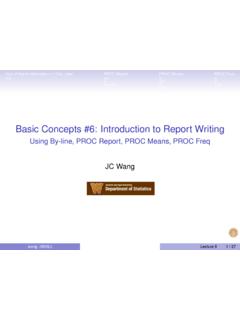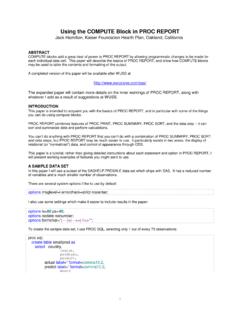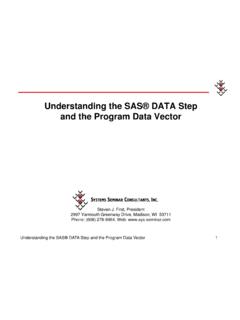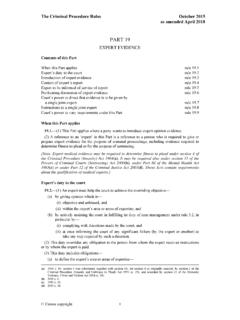Transcription of 149-2012: Queries, Joins, and WHERE Clauses, Oh …
1 SAS Global Forum 2012 Hands-on Workshops Paper 149-2012. queries , joins , and WHERE clauses , Oh My!! Demystifying PROC SQL. Christianna S. Williams, Chapel Hill, NC. ABSTRACT. Subqueries, inner joins , outer joins , HAVING expressions, set operators just the terminology of PROC SQL might intimidate SAS programmers accustomed to getting the DATA step to do our bidding for data manipulation. Nonetheless, even DATA step die-hards must grudgingly acknowledge that there are some tasks, such as the many- to-many merge or the "not-quite-equi-join," requiring Herculean effort to achieve with DATA steps, that SQL can accomplish amazingly concisely, even elegantly. Through increasingly complex examples, this workshop illustrates each of PROC SQL's clauses , with particular focus on problems difficult to solve with traditional SAS code.
2 After all, PROC SQL is part of Base SAS so, although you might need to learn a few new keywords to become an SQL. wizard, no special license is required! INTRODUCTION. PROC SQL is an incredibly powerful tool for data manipulation in SAS. However, SQL thinks about data a bit differently than traditional' SAS, and these difference run deeper than terminology beyond the question of whether we talk about tables or datasets', columns' or variables, observations' or rows'. Sometimes these differences can perplex accomplished SAS programmers. Nonetheless, because of the ability of SQL to combine data aggregation and linkage, not to mention flexibility in joins far beyond what is feasible in a DATA step MERGE, SAS programmers who need to rearrange their data ignore PROC SQL at their peril.
3 I've been using the DATA Step and other traditional' SAS tools like PROC SUMMARY and MEANS for a very long time, but I've come to appreciate how PROC SQL can simplify many data manipulation tasks. I have learned some of this through trial and error and trying many things that I thought would work but didn't and then going on to figure out how to make it work. I'm hoping to share some of what I've learned about SQL in this paper, through lots of examples. In an earlier conference paper that I've presented several times, PROC SQL for DATA Step Die-Hards', every example was a comparison of DATA. Step and SQL methods. I'm not using that approach in this paper for a couple of reasons. One is that more and more programmers are learning SQL in tandem with the DATA Step, so the translation' issue is not as important.
4 Another is that for some of the examples in this paper, it would just be silly to try to do them with the DATA step. And the third is that, without having to go through lots of DATA Step examples, I can present even more SQL!! Still, I. can't help but make references throughout to how the processing differs between SQL and the DATA Step; if you are not a DATA Step-per, you can just ignore these interludes. Let's go! THE DATA. First, a brief introduction to the data sets. Table 1 describes the five logically linked data sets, which concern the hospital admissions and emergency room visits for twenty completely fictitious patients. The variable or variables that uniquely identify an observation within each data set are indicated in bold; the data sets are sorted by these keys.
5 Complete listings are included at the end of the paper. Throughout the paper, it is assumed that these data sets are located in a data library referenced by the libref EX. Data set (Table) Variable (Column) Description ADMISSIONS pt_id patient identifier admdate date of admission disdate date of discharge hosp hospital identifier bp_sys systolic blood pressure (mmHg). bp_dia diastolic blood pressure (mmHg). dest discharge destination primdx primary diagnosis (ICD-9). md admitting physician identifier 1. SAS Global Forum 2012 Hands-on Workshops Demystifying SQL, continued Data set (Table) Variable (Column) Description PATIENTS id patient identifier lastname patient last name firstname patient first name sex gender (1=M, 2=F). dob date of birth primmd primary physician identifier zipcode patient residence zip code HOSPITALS hosp_id hospital identifier hospname hospital name zip hospital zip code beds number of beds has_er Y if hospital has ER, N otherwise DOCTORS md_id physician identifier hospadm hospital at which MD has admitting privileges lastname physician last name Table 1.
6 Listing of tables and variables used in examples. Records on each table are uniquely identified by the columns that are in bold; tables are also sorted by these variables EXAMPLE 1: SUBSETTING VARIABLES (COLUMNS) AND OBSERVATIONS (ROWS). In this first, extremely simple example, we just want to create a subset of the ADMISSIONS data set that contains selected variables (columns) for all the admissions to the Tarheel Hospital (hosp=3). The PROC SQL code shown below for Example 1a demonstrates how to do this when you just want to produce a report' or listing of the selected rows and columns that is, no new data set (table) is produced. In addition to the PROC SQL statement, which, of course, invokes the procedure, this simple example demonstrates a simple query (which always starts with the keyword SELECT) and two clauses .
7 In the first part of the SELECT. statement, we specify the columns that we want in our report. Note that they are separated by commas, which can always be a bit tricky for those of us used to just delimiting lists with spaces in the DATA step. The FROM clause, which is the only required clause in a SELECT statement, specifies the entity or entities (here a single data set) on which the SELECT statement is acting. And the WHERE clause, which is optional, places conditions on the rows that will be selected from the entities in the FROM clause here specifying that we want the rows that have the HOSP. variable with a value of 3. Note that although I've placed them on separate lines for clarity, both the FROM and WHERE clauses are part of the SELECT statement and therefore, there is no semi-colon until the end of the WHERE clause.
8 As an interactive procedure, the RUN statement has no meaning for SQL. A single PROC SQL. statement can have multiple queries (SELECT statements). A step boundary is forced by the QUIT statement. TITLE1 'SGF 2012 - queries , joins & WHERE clauses - Demystifying SQL';. TITLE3 'Example 1 - Subsetting variables (columns) & observations (rows)';. TITLE4 '1a - Produce a "report" with desired columns and rows';. PROC SQL;. SELECT pt_id, admdate, disdate FROM WHERE hosp EQ 3;. QUIT;. Assuming that you are sending your printed output to the listing destination, the code above will produce the output shown in Output 1a. Note that, unlike in PROC PRINT, which would be another way to produce a very similar report, PROC SQL will by default but the variable labels at the tops of the columns, rather than the variable names.
9 If a variable has no label, the column header will be the variable name. If you do NOT want the labels at the tops of the 2 SAS Global Forum 2012 Hands-on Workshops Demystifying SQL, continued columns, you can use the SAS global option NOLABEL; this will stay in force until you reset with LABEL option. Additionally, SQL does not number the rows in the output by default; if you want row numbers, use the NUMBER. option on the PROC SQL statement. Example 1 - Subsetting variables (columns) & observations (rows). 1a - Produce a "report" with desired columns and rows Patient Admit Discharge ID Date Date . 003 17 OCT2010 21 OCT2010. 003 15 NOV2010 15 NOV2010. 005 11 APR2010 28 APR2010. 008 01 OCT2010 15 OCT2010. 008 26 NOV2010 28 NOV2010.
10 014 17 JAN2011 20 JAN2011. 018 01 NOV2010 15 NOV2010. 018 26 DEC2010 08 JAN2011. Output 1a. Result of Example 1a, selecting rows and columns The code above requires only a small tweak if you wish to generate a new SAS data set with the desired rows and columns instead of a listing. As shown below, you simply add the CREATE TABLE clause before the SELECT, specifying the name you wish to give the new table after the TABLE keyword. The AS keyword is also required; in effect it says that the table name provided (here EX1) is an alias for the result of the subsequent query. When you use PROC SQL to generate a new data set in this way, there is no printed output generated. You could get a listing by either executing another simple SELECT query (on the new data set) or by a PROC PRINT step, as shown below.















